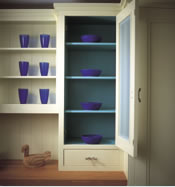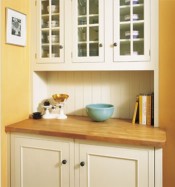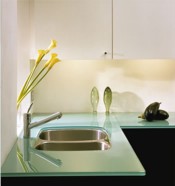



January 2003
Product Planner Aids Roundhouse Expansion
|
|
|
Typical Roundhouse furniture, combining panel, solid timber in different finishes and even stainless steel. In Product Planner language, MBO3, SSTL, WS42, and RAD. Using simple codes, Linkwood created a comprehensive system incorporating all these diverse elements, which Roundhouse could easily customise while inputting the job. |
When Roundhouse first met Linkwood at Woodmex in 2000 they were suffering the classic growing pains of a small manufacturing business.
Roundhouse specialise in quality bespoke kitchen furniture, Linkwood is the UK arm of Pattern Systems International who offer a range of software solutions for woodworking companies just like Roundhouse, so the meeting proved fortuitous.
Two years on, Pattern Systems software is at the cornerstone of all aspects of Roundhouse’s manufacturing systems, and has also been expanded to provide invoicing and delivery notes, as well as all manufacturing data like monthly output reports.
Roundhouse works manager, Simon Smith takes up the story. “We had grown quickly from three or four men making one offs in a small joinery shop to a situation where we were employing far more people making far more stuff, all of it different, and most of it being made differently depending on who did the cutting list. It was unsatisfactory and we wanted something that would give us a much tighter structure.”
At the heart of that is Product Planner, powerful manufacturing software which generates accurate cutting lists. It took more than a year to fully develop an individual catalogue for Roundhouse who offered both in frame and lay on cabinetry in an almost infinite variety of unit combinations.
The brief to Linkwood was that the product catalogue created had to expand the horizons of the business rather than limit them. The company’s niche is in manufacturing truly bespoke individual kitchens and Product Planner had to enhance that process, not compromise it.
Linkwood managing director Bob Hockey explains. “Roundhouse’s catalogue was very complex compared to some, but as we worked with them we understood all the different parameters that applied to their different ranges and came up with formulas which would suit their cabinetry.”
So rather than Product Planner restricting choice for Roundhouse, the company in fact found it easier to broaden choice by extending the parameters in the basic Product Planner package.
Smith says, “We worked very closely with Linkwood, and I was impressed with the way in which they quickly understood how we made our different products, and what we wanted to achieve.
|
|

|

|

|
|
Linkwood’s task was complicated not just by the range of materials, the top-left kitchen photo is a mix of solid acrylic and stainless steel, but also by the fact that Roundhouse offered completely different in frame and lay on products which both had to be incorporated into one product catalogue. |
|
“Now when we start a job we have a whole host of variables which we can input, different materials and finishes, then put in the individual units and know at the end of it exactly what materials and ironmongery we require. We’ve been able to cut waste, and stock levels drastically.”
Aside from certain frequently used panels and fittings everything is bought in on a job by job basis, with Product Planner and its linked product Cut Planner making all the calculations. This has freed up workshop space and saved substantial amounts.
Smith says, “By working long and hard with Linkwood to get waste factors and costings right, we are getting far more out of Product Planner than a mere cutting list service.”
According to Bob Hockey most companies rely on Product Planner for just this basic service, but he says “Roundhouse have worked with us to develop the use of our software way beyond what most of our customers ask for, and now they are reaping the benefits of seeing that potential from the start.”
A typical job will now take between 30 and 45 minutes to input. But to ensure the job flows through the factory even the most complicated jobs are input using standard products in the Product Planner catalogue as a starting point.
It is a straightforward process to customise items already in the product catalogue. Smith says, “Using the system now is a doddle. We know our way around it and what it can do. We can input all sorts of weird and wonderful stuff we’ve been asked to make without a problem.”
The Product Planner cutting schedule is linked to other Pattern Systems software. Roundhouse generate an assembly schedule, detailed timber list including all jointing instructions, optimised cutting lists with labelling for all panels, delivery note with finished product label, order confirmation for the sales person and final invoice. Everything the organised factory manager could want.
But for Smith there is more besides. “Standardising cutting lists was only the very beginning of what we wanted. Pattern Systems appealed to us because of the add ons. We have linked Cut Planner to another piece of software, Drill-Mate, which generates all our drillings for CNC. That gives us greater accuracy and ensures that what we input in production planning is carried out by the joiner carrying out the assembly.”
The drilling code is also contained on the label, and so are edge banding instructions. These labels have provided major savings for both machine and assembly operators with all panels clearly identified. It sounds a small thing but how many frustrated managers and supervisors watch staff spending hours vainly trying to work out how a pallet full of components goes together?
Again that level of organisation has repercussions in terms of labour cost savings.
Labour values for every item from a set of drawers to a piece of filler have been included in Product Planner, split between machine shop, assembly, spraying, fit up and despatch. At a key stroke Roundhouse can analyse exactly how long each job should take, compare it against actual time taken and check efficiency accordingly.
Now Roundhouse have installed computerised clocking in and time measurement for jobs, the next phase will be a bonus scheme.
Smith says, “That will undoubtedly increase our productivity again. It wasn’t something we wanted to rush into. Product Planner had to be absolutely accurate before we could even consider a bonus scheme. We’re confident we are there now.”
|
|
|
For all the drive towards computerisation for accuracy, Roundhouse still set great store by hand crafting bespoke products. Product Planner’s role was to generate accurate, labelled parts for skilled men to have more time to work with. |
There is one further step for Roundhouse to undertake in conjunction with Linkwood and Pattern Systems. That will be upgrading the panel optimising package to control a beam saw.
Linkwood and Pattern Systems have worldwide experience linking software to computer controlled wood working machinery and Smith will talk to Linkwood before making the final choice.
Bob Hockey says, “We are always happy to offer any extra help we can to our customers. Pattern Systems has a huge understanding of the woodworking industry, and there is usually someone somewhere who has machinery linked to our software.”
Installation of the beam saw will be the final piece in the process Roundhouse set out to achieve after first deciding to work with Linkwood and Pattern Systems.
So does Smith have any advice for manufacturers thinking about computerisation? “Basically work out what you want to achieve then stick with it. It will take longer than you think to get 100per cent right, but it’s a process you can’t stop without throwing time and money away.
“We made the mistake of thinking we had cracked it quite early on. We hadn’t, and although Product Planner is
100 per cent accurate, we have more checks now than we ever did before. What we don’t have now are re-works caused by error in manufacturing.”
Also early in the process, Smith decided that Linkwood had to write the catalogue.
“We would never have had time to do it to the depth we wanted. It was great to be able to say, ‘make it do this, this and this and then give me these reports’, and to have someone who would just go away and do it. That really was money well spent.”
Hockey says, “Roundhouse is a fine example of what can be achieved by a manufacturer keen to explore the potential of Pattern Systems products fully. They have proved we have an off the shelf system, allied to our own expert consultancy, which can provide tailor made solutions for small and medium sized manufacturing businesses.”